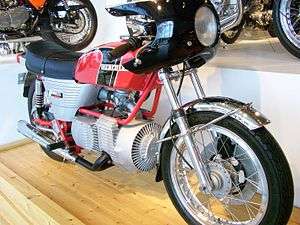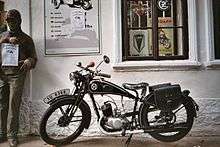Hercules (motorcycle)
Hercules was a brand of bicycle and motorcycle manufactured in Germany.

The Hercules Company was founded in 1886[1] to produce bicycles[2] by Carl Marschütz in Nuremberg, Germany[3] and began producing motorcycles in 1904. It was merged with Zweirad Union after being purchased by ZF Sachs in 1963.[4]
In the 1950s and 1960s Sachs was the largest European fabricator of two-stroke motorcycle engines.[5] Many of these engines were used in the Hercules line of small motorcycles, scooters and mopeds.
In 1974 Hercules became the first company to offer a Wankel-engined motorcycle for sale to the general public. A prototype was first shown in 1970 at the West Cologne Autumn Motorcycle Show to a mixed reception and the production bike was sold as a Hercules product except in the United Kingdom, where it was marketed as a DKW motorcycle. The W-2000 had a single-rotor air-cooled engine of 294cc displacement that produced 23 hp, later increased to 32 hp. Cooling was by a large fan placed in front of the engine (and the slipstream breeze while riding) and engine lubrication was by manually adding oil to the fuel in the tank.[6]
In 1976 Hercules launched the W-2000 Injection in which engine lubrication was from a separate oil tank via a pump. It had 18-inch wheels, a front disc brake and a rear drum brake. According to a March 1976 review in Cycle World, the handling was good but the bike's low ground clearance limited its cornering ability. That review also declared the W-2000 to be a daily commuting bike, not a sport motorcycle.[6]
Hercules introduced a rotary-powered dirt bike (the KC-30 GS Enduro) in May 1975, but the model failed to sell due to its high price ($2,900).[6]
The Fichtel & Sachs single-rotor engine of 300 cc swept-volume as used in the Hercules – the only commercially available engine at the time – was used as a basis by BSA's project engineer David Garside in the early 1970s when designing a twin-rotor motorcycle engine of 588 cc, which reached production as the "Norton Classic".[7]
Production of motorcycles ceased in 1996.
Partial product line

- Hercules K500 1932–1936
- Hercules s125 1939–1943
- Hercules b50 1932–1935
- Hercules Moped, 49cc (1957)
- Hercules Scooter, 50cc
- Hercules Ultra III Sachs 50 SW
- Hercules Lilliput, 98cc
- Hercules MK1 moped
- Hercules MK2 moped
- Hercules MK3 moped
- Hercules MK4 moped
- Hercules supra 4gp moped
- Hercules supra 4 enduro moped
- Hercules Prior Moped
- Hercules Lastboy
- Hercules K100 (1959)
- Hercules R 200 (1959)
- Hercules 220 (1965)
- Hercules 103 (1966)[8]
- Hercules Postie Bike (1969)
- Hercules K 105 X (1970)
- Hercules K 125 X (1971)
- Hercules K 50 RX (1971)
- Hercules K 125 Military (1971–1990)
- Hercules K 125 (1972)
- Hercules K 125 T (1973)
- Hercules K125 S (1974–1979)
- Hercules W-2000 (1974–1978)
- Hercules E1 (1974)
- Hercules KC-30 GS Enduro (1975)
- Hercules 175 GS (1976)
- Hercules 502 GS (1976)
- Hercules GS250 Ice Racer (1977)
- Hercules MC250 (1978)
- Hercules DKW 250 GS (1978)
- Hercules Prima 5S (1984)
- Hercules Prima frisiert
- Hercules GS 125B
- Hercules KJBe
- Hercules K 180 Military (1991–1996)
References
- Deutsche autos, Motorbuchverlag
- "1939 Herrenrad Hercules (Fahrrad Werke, Nurnberg)". www.OldBike.eu – the Online Bicycle Museum. Retrieved 2016-07-06.
The German Hercules bicycle is a large and powerful machine
- Tracy, David. "Let's Have A Close Look At The Hercules W-2000: The World's First Rotary Motorcycle". Jalopnik. Retrieved 8 January 2018.
- History - Official Sachs Bikes website Archived February 7, 2009, at the Wayback Machine
- dropbears.com. "Hercules Motorcycles". cybermotorcycle.com. Retrieved 3 September 2014.
- Williams, Greg. "Hercules W-2000: The First Rotary-Powered Motorcycle". Motorcycle Classics March/April 2012. Motorcycle Classics. Retrieved 7 December 2012.
- Motorcycle Mechanics, December 1974, pp.41–43. NVT's Wankel. Interview with David Garside by John Robinson. Intro: "After five years of research and rather touchy secrecy, Triumph suddenly announced their very own version of a rotary engine to the Press and put one on show at Cologne". Garside: "We started with the only commercially available engine, the Fichtel and Sachs, which gave about 20hp. So our first thought was to double the rotors to get around 40hp and then by development...we've got it up to target. On the test bench we've even had 80hp running with open exhausts". Accessed 2014-05-12
- https://web.archive.org/web/20160303224044/http://www.cybermotorcycles.com/gallery/hercules/index.htm. Archived from the original on March 3, 2016. Retrieved June 27, 2009. Missing or empty
|title=(help)